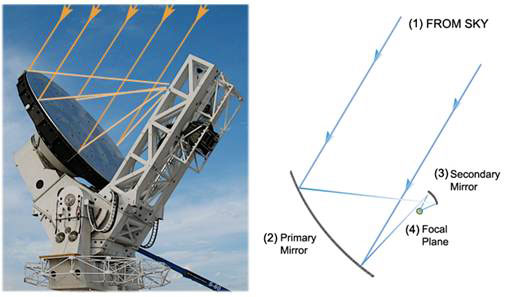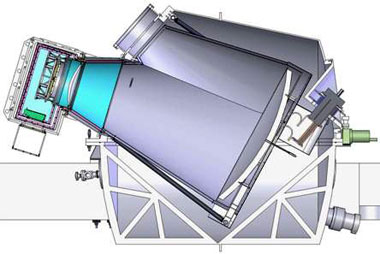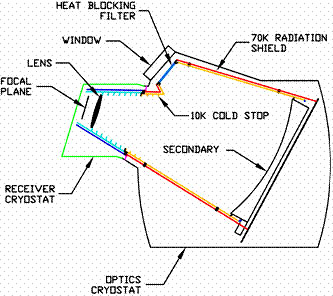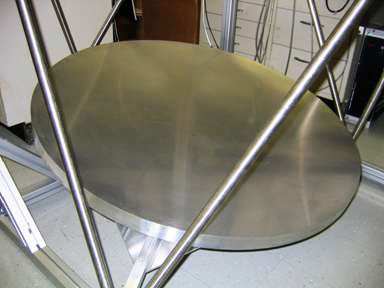|
|
 TELESCOPE OPTICS TELESCOPE OPTICS
The South Pole Telescope is designed to measure the properties of the Cosmic Microwave Background (CMB) light that was originally created billions of years ago in the infant universe. Most of this light has traveled freely through empty space since its creation, and it arrives at the earth from all directions in the sky. The SPT is designed to map this radiation over large patches of the Southern sky. Tiny features in these maps will indicate where clusters of galaxies have slightly altered the primordial CMB light, and through studying these clusters we can learn about the evolution of structures in the universe.
A set of detectors absorbs the incoming CMB radiation as the entire telescope is swept back and forth to point at different places in the sky. The CMB radiation coming from the sky is very faint, and a major challenge to observing it from the ground is shielding the telescope from radiation coming from other things in the local environment. Even though it is very cold at the South Pole, objects in the local environment as well as distant buildings are warm enough that they "glow" with radiation that needs to be kept away from the detectors. So in addition to the optical components needed to collect and focus the CMB light, the telescope has been designed with several ways to block unwanted radiation from the surrounding environment
|
| |
 | PRIMARY MIRROR |
|
 |
|
| |
The primary mirror for the South Pole Telescope is 10 meters in diameter, which is very large! If you stood it on one edge, it would be as tall as a three-story building. Such a large mirror is needed for two reasons. First, a larger telescope makes sharper images. This is important because the objects that we hope to find with the first-generation SPT camera - distant galaxy clusters - are small enough that they would look blurry to a smaller telescope operating at our wavelengths. Second, a larger telescope gathers more light. This allows the SPT to have hundreds --- even thousands --- of detectors in the first-generation camera, with each detector absorbing a portion of the light collected by the optical system.
|
| |
 Light comes in from the sky and bounces off the primary mirror. The picture on the left shows the telescope during the test-build in Texas in Summer 2006, before the rest of the optical system were installed. On the right is an illustration showing the path of light through the final telescope design.
Light comes in from the sky and bounces off the primary mirror. The picture on the left shows the telescope during the test-build in Texas in Summer 2006, before the rest of the optical system were installed. On the right is an illustration showing the path of light through the final telescope design.
|
| |
 | DOWNSTREAM OPTICS |
|
 |
|
| |
Light that hits the primary mirror is reflected toward a large part of the SPT instrument called the "optics cryostat". There, it travels through a transparent window into a vacuum chamber, where a 1-meter secondary mirror reflects it again. Finally, it travels through a lens and into the "receiver cryostat", where it is absorbed by the detectors. The simplicity of this optical arrangement helps to make it easier to keep the telescope in good alignment. Also, any part of the telescope itself that is not kept extremely cold will "glow" with its own radiation, so we want to have as few optical components as possible. Radiation coming from parts of the telescope will be detected in the same way as CMB radiation is detected, and will contribute to "noise" in the detected signal.
To minimize radiation from elements of the telescope itself, all of the optics except the primary mirror are kept cold. The secondary mirror and the lens are kept at 10 degrees above absolute zero. The very sensitive detectors that make up the "receiver" or "camera" for the SPT actually need to be operated at much lower temperatures, at barely half of a degree above absolute zero!
|
| |
 The picture shows the "optics cryostat", which holds the secondary mirror and the lens that make up the rest of the SPT optics. The main components of the optics cryostat are kept at 10K, or ten degrees above absolute zero. Light comes in through the window at the top and then is reflected through the lens onto the focal plane inside the "receiver cryostat", which is mounted below the window.
The picture shows the "optics cryostat", which holds the secondary mirror and the lens that make up the rest of the SPT optics. The main components of the optics cryostat are kept at 10K, or ten degrees above absolute zero. Light comes in through the window at the top and then is reflected through the lens onto the focal plane inside the "receiver cryostat", which is mounted below the window.
|
| |
 A schematic with the different parts labeled.
A schematic with the different parts labeled.
|
| |
 A photograph of the secondary mirror, sitting in Steve Padin's University of Chicago office, where he and graduate student Ryan Keisler were doing careful measurements of the mirror surface.
A photograph of the secondary mirror, sitting in Steve Padin's University of Chicago office, where he and graduate student Ryan Keisler were doing careful measurements of the mirror surface.
|
| |
 | SHIELDING |
|
 |
|
| |
Also important for reducing noise at the detectors is the shielding in the optical design. The detectors only "look at" the inner 8 meters of the primary mirror; the outer 2 meters are a buffer to minimize the amount of light that gets on the detectors from places other than the sky. There are also shields along the side of the secondary boom. In the second year of observing a massive ground shield will surround the entire telescope. This ground shield will ensure that very little light from the ground can get to the telescope.
|
| |
 Plans for the enormous ground shield that will eventually be placed around the telescope to block out radiation from the local environment.
Plans for the enormous ground shield that will eventually be placed around the telescope to block out radiation from the local environment.
|
| |
|
|
 TELESCOPE OPTICS
TELESCOPE OPTICS